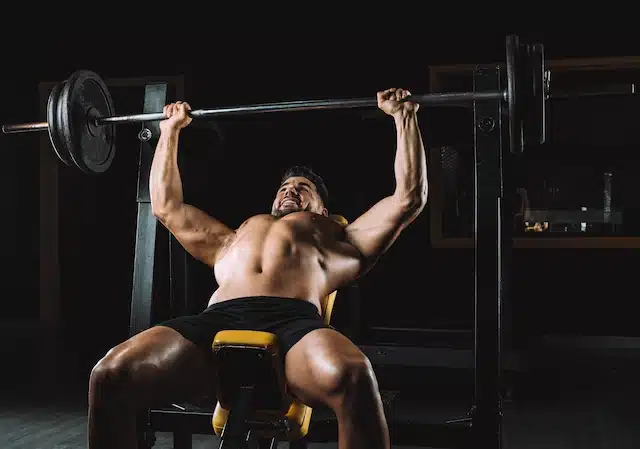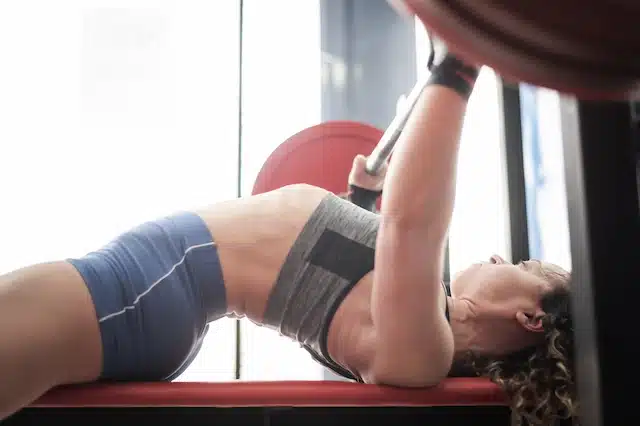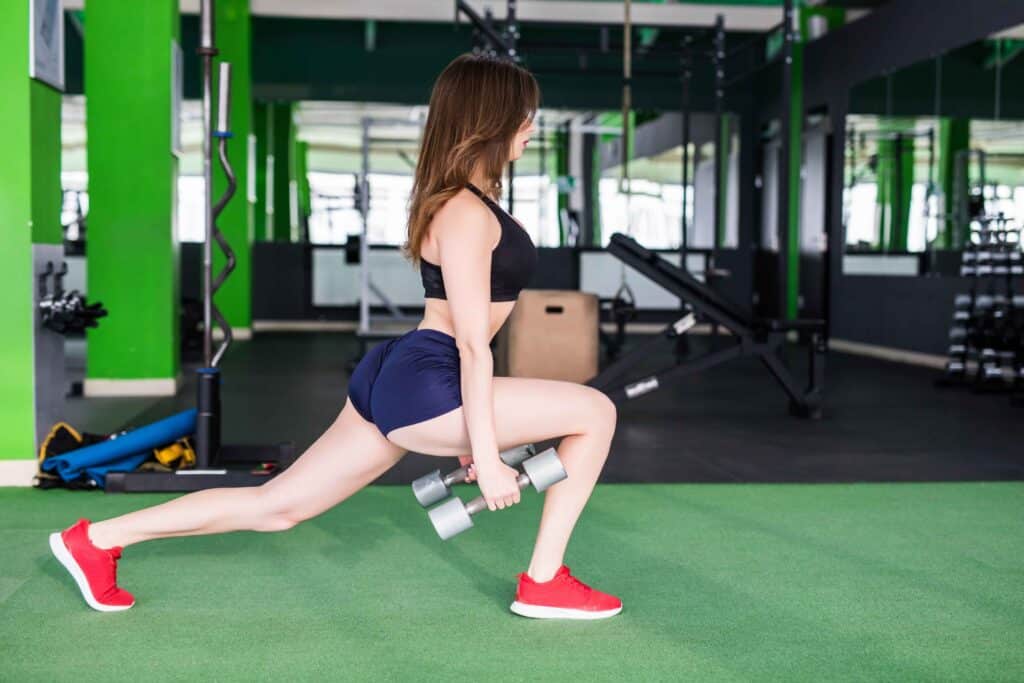Struggling with bench pressing? Arching your back might help. Studies show arching increases your 1RM—your max lift for one rep. This article breaks down why and how an arched back can up your game, making lifting safer and more effective.
Key Takeaways
- Arching your back during bench press keeps your shoulder joints safe. It lets you lift more weight by improving stability and using big chest muscles.
- Doing the arch right means less pain in shoulders and a stronger upper body. But, too much arch can hurt your lower back.
- Proper form includes keeping feet flat, squeezing glutes, and pulling shoulder blades together. This helps use more muscle and protects joints.
- Add exercises like foam rolling, spine stretches, and knee raises to make your arch better. These build flexibility and strength.
- Learn the correct way to set up on the bench. This includes placing feet wide for balance, gripping the bar tight, and pressing buttocks onto the bench without lifting them off during the press.
Why Lifters Use a Bench Press Arch
Lifters use a bench press arch to make their lift safer and stronger. This arch helps keep the shoulder joints safe and lets them push more weight.
Enhanced Stability
Arching your back helps keep your body stable on the bench. This stability comes from full-body tension, which includes tight leg drive and retracted shoulder blades. It’s like setting a strong foundation for a house.
A strong arch means less wobble and more power.
This setup reduces movement of shoulders during pressing, protecting them from injury. Next, we’ll see how it also makes lifting safer for shoulders.
Improved Shoulder Safety
Experts like Dr. Quinn Henoch and Dr. Mike Israetel confirm, a moderate arch in bench pressing helps keep shoulders safe. This method activates lower pectoral muscles more effectively too.
So, the risk of shoulder pain drops a lot with proper arching.
A good arch cuts down on how far you need to move the barbell. This means less stress on your rotator cuffs and deltoids during heavy lifts. Safe shoulder action is key for long-term upper body strength without injury.
Potential for Lifting More Weight
Using an arched back in bench-pressing lets lifters push up more weight. A study shows that 15 powerlifters lifted heavier weights this way. This technique increases muscle activation, especially in the pecs and lats.
More muscle works harder during each lift, helping to move bigger barbell weights.
This method also changes how far the bar travels. It shortens the range of motion. So, arms don’t have to push as far. This makes lifting heavy items easier and allows for greater barbell velocity.
Lifters can achieve their best one-repetition maximum with less effort by using an arch.
Benefits of Using a Bench Press Arch

Adding a back arch in your bench press can make you stronger and protect your shoulder joints. It lets you press more weight by involving big chest muscles and making sure your body is firm on the bench.
Safer on the Shoulders
Arching your back the right way during a bench press makes it safer for your shoulders. It puts shoulder blades in their best spot. This method cuts down on injuries and stress in that area, making every push-up better for your upper body.
With optimal position comes less pain and more gains.
Using this arch also means no axial loading on your spine — a big plus for safety. Shear loading is less with good form, protecting lower back and neck alike. Your shoulders stay safe, strong, and ready for more weight each time you lift.
More Overall Stability
Arching your back during a bench press creates a firm base. This base helps keep you stable on the bench. With this stability, every push uses your strength fully. You won’t waste energy wobbling or trying to find balance.
Legs play a big part too. They drive into the floor, making your whole body tight and ready for lifting.
Stability means less injury risk and better lifts. Think of it like building a house; a strong foundation makes everything else work better. With arching, you’re protecting your spine while using more muscle groups effectively—like lats in pulling moves or legs in squats—to lift heavier weights safely.
Increased Muscle Engagement
An arch in bench pressing helps hit chest muscles from new angles. This means pecs work harder, leading to better growth. Studies show this method does not cut down on muscle use; it boosts it.
Lats play a big part too, supporting the move and adding power.
Using an arch also makes other upper body parts join in more. Shoulders and triceps get a good workout, helping lift more weight safely. This way, every push engages more muscles across the chest and arms, making each rep count for more strength and size gains.
Risks Involved with Arching
Arching your back in bench press can stress your lower back and might not work some muscles as much. Keep learning to stay safe and strong!
Potential Lower Back Strain
Creating a big arch during bench press helps in many ways, but it can also put strain on the lower back. Dr. Mike Israetel says force on the lower back is lower than during light squats.
Yet, too much arching might lead to back injury. It’s like when you bend a wire back and forth too much; eventually, it might break.
Risks of excessive arching include potential lower back injury.
People need to find a balance. Too little arch and you miss out on benefits like more stability and shoulder safety. Too much and your back pays the price. Think about keeping your back safe while still getting those gains by watching how much you arch.
Possible Reduced Muscle Mass in Certain Areas
Using a bench press arch might make certain muscles smaller. Because the range of motion gets shorter, muscles do less work. This means they spend less time under pressure. Mainly, chest and arm muscles might not grow as big if you always use a big arch.
So, lifting this way can lead to uneven muscle growth.
For instance, powerlifters often have strong backs and shoulders but might lack size in their pecs or arms. They focus on lifting more weight by changing how they move during exercises like the decline bench press or deadlift.
This method is good for winning competitions but doesn’t always make all muscles bigger or stronger equally.
How to Properly Arch in Bench Press
To arch right in bench press, get a snug fit on the bench. Place your feet firm on the ground and grip tight. Then, push your chest up high while keeping your back safe. This move makes you strong and steady when you lift.
Want to boost your skills? Keep reading for more tips!
Setting Up on the Bench
Setting up on the bench is key for a good bench press arch. It makes you stable and safe. Here’s how to do it right:
- Lie down on the bench. Keep your eyes under the bar.
- Place your feet flat on the floor. They should be wide apart for balance.
- Push your feet down hard. This helps with stability.
- Pull your shoulder blades together. Your upper back should be tight.
- Press your buttocks onto the bench. They must not lift off during the press.
- Make sure your head, shoulders, and buttocks touch the bench all through.
- Arch your lower back just enough but keep those contact points in mind.
- Grip the bar wider than shoulder-width. This position helps engage more muscles.
- Use a spotter when lifting heavy weights for extra safety.
Each step helps create a strong foundation for bench pressing, reducing risks and improving performance.
Stance and Unracking Techniques
Stance and unracking are essential elements of a high-quality bench press. They establish the foundations of a successful start.
- Be thoughtful about your grip width. This element influences your lift. A more extensive grip exercises more on your chest muscles. A more limited grip concentrates on your triceps and shoulders. Discover the most effective position for you.
- Keep feet solidly on the ground. Your stance needs to be stable to maintain equilibrium during the lift.
- Ensure your eyes are beneath the bar before lifting. This tactic aids in aligning your body accurately.
- Compress shoulder blades together, flat against the bench. This action boosts stability and safeguards shoulders.
- Curve your back slightly but maintain your buttocks and upper back on the bench to avoid undue tension.
- Grasp the bar tightly with the entire hand, not just fingers, for optimal control.
- Raise the bar off the rack with straight arms and relocate it over your chest area, not face or stomach.
- Inhale prior to lowering the bar to remain stable and controlled.
- Modify hips or feet if they elevate or slide during the lift to sustain a fortified position.
Each movement is crucial, from the initial setup to executing the lift flawlessly.
Lowering and Pressing Dynamics
Lowering and pressing the bar in bench press needs good form. This helps lift more weight safely. Here are the steps:
- Grip the bar tight. This activates your upper body muscles, like pecs and lats.
- Keep your feet flat on the floor for balance.
- Lower the bar to just above your chest. Do not let it sink or move around.
- Push through your feet. Use leg drive to help push up.
- Squeeze your shoulder blades together while pressing up.
- Keep your elbows under the bar to protect shoulders.
- Breathe out as you push the bar up.
- Aim for a smooth motion, no jerking or pausing.
These steps make sure you use proper leg drive and thoracic arch, keeping a stable base throughout the exercise.
Next, we’ll look at how to enhance your bench press arch with specific exercises and adjustments.
Enhancing Your Bench Press Arch
To make your bench press arch better, focus on specific exercises and posture tweaks. Adding moves like knee raises and static stretching can build flexibility, while also strengthening your back muscles for improved support during the lift.
Exercises for Flexibility and Strength
Flexibility and strength are key for a strong bench press arch. Dynamic foam rolling and thoracic spine stretches make your back more flexible.
- Foam roll your upper back for 5 minutes daily. This loosens tight muscles.
- Perform thoracic spine stretches for 10 minutes each session. It helps improve your range of motion (ROM).
- Do face pulls with a resistance band to strengthen upper extremity muscles, three sets of 12 reps.
- Practice knee raises to activate flexors and improve lower body stability, aim for three sets of 15.
- Incorporate squats into your workout twice a week to boost leg power and balance, ensuring you squat deeply.
- Use the incline bench press to hit the pec muscles from different angles, two times a week with moderate weight.
- Engage in static stretching after workouts, focusing on lats activation for better pushing up power.
Now, let’s talk about setting up on the bench properly.
Postural Adjustments
Pulling shoulders back and together creates tension. This move is key in bench pressing to avoid pain and injury. Here’s how to make postural adjustments:
- Push your feet flat on the floor. This steadies your whole body.
- Squeeze your glutes. It helps keep your lower back safe.
- Pull your shoulder blades down and back. This guards against shoulder pain.
- Keep a slight arch in your lower back. Such a curve is natural.
- Make sure your head stays on the bench during the lift.
- Tighten your core muscles as you press up. This adds more power.
- Adjust grip width for comfort and efficacy in engaging chest muscles.
These steps ensure each lift maximizes muscle engagement while keeping joints secure.
Conclusion
Arching your back in bench pressing is key for lifting more weight safely. It gives you better stability and protects your shoulders. A proper arch can also increase muscle use in each lift.
Make sure to learn how to do it right to avoid any strain on your lower back. Practice and improve flexibility for a stronger arch, helping you get the most from your bench press routine.
FAQs
1. Why should I arch my back while bench pressing?
Arching your back during a bench press, known as lordosis, can help with powerlifting. It aligns the vertebrae and reduces risk of injury.
2. Is it considered cheating to arch your back in powerlifting federations?
No, it’s not cheating. In fact, many powerlifting federations allow and even encourage it for better resistance training results.
3. How does squatting relate to the bench press technique?
Squatting and bench pressing share similarities in form like retraction of the shoulder blades – just like you do when performing a back squat.
4. Does electromyography support arching your back while bench pressing?
Yes! Electromyography studies show that an arched position activates more muscles, leading to improved performance.







